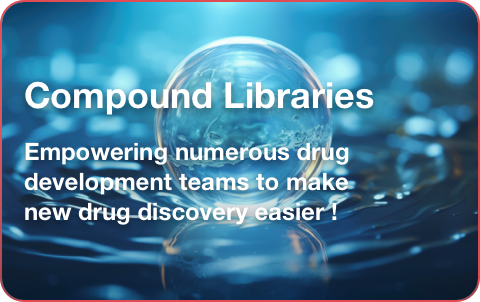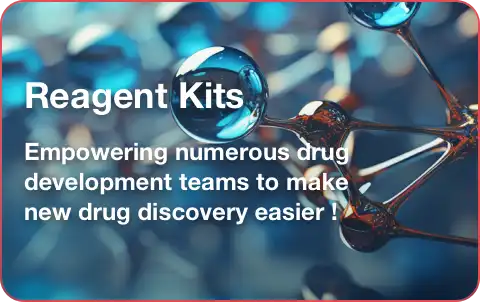- Remove All
 Your shopping cart is currently empty
Your shopping cart is currently empty
Technical Support
Inhibitor Products
QDoes the compound differ in any way when it is in the form of hydrochloride or sulfate ions? What is the difference between the salt form and the free form?
AThe molecules in salt and non-salt forms exhibit the same activity, and they have consistent effects in biological experiments. Their activity and usage are identical. The only difference lies in their salt forms, which may result in variations in physical properties such as solubility. It is recommended to choose based on solubility and experimental requirements.
QHow to recommend specific or broad-spectrum inhibitors for a target? What is the difference between specificity and nonspecificity?
AInhibitors can be classified into two types based on specificity: broad-spectrum (pan) and selective inhibitors. Pan inhibitors are inhibitors of a particular target that have inhibitory effects on all subtypes or members of the entire family. Selective inhibitors have particularly high inhibitory rates or specific inhibitory effects on a subtype of a protein kinase or a member of a family of proteins. The evaluation of the inhibitory efficiency of an inhibitor generally relies on the IC50 value, with lower IC50 values indicating higher inhibitory efficiency. We recommend considering the above characteristics comprehensively when selecting inhibitors, and you can also contact our technical team for recommendations on relevant inhibitors.
QWhat’s EC50?
AHalf maximal effective concentratioin(EC50) refers to the concentration of a compound that achieves 50% of the maximum effect(inhibitory/stimulatory effect),after a specified exposure duration.
QWhat’s ED50?
AEffective dose 50 (ED50)refers to the dose of a drug that produces a specific effect in 50% of the population that has been administered that dose.
QWhat’s IC50?
AHalf-maximal inhibitory concentration (IC50) refers to the concentration of the inhibitor which is required to inhibit a given biological or biochemical function by half.
QWhat’s Ki?
AInhibitory consent (Ki) reflects the strength of inhibitor binding to the target, corresponding to the concentration of free inhibitor when 50% of the target is bound by the inhibitor.
QWhat’s Kd?
ADissociation consent (Kd) reflects the affinity of a compound for its target. In some cases, it can be equivalent to Ki.
QWhat’s pIC50?
ApIC50 is the negative log of the IC50 value when converted to molar.That is, pIC50=-log(IC50).
Signaling Pathways
QHow to store inhibitor products?
ASolid-form products can be stored at -20°C for more than 3 years. Stock solutions are typically stored at -80°C and can be stored for more than 1 year. It is recommended to aliquot the product to avoid repeated freeze-thaw cycles. For short-term storage, samples can be kept at 4°C for more than one week.
QDoes the product need to be protected from light?
AGenerally, for molecules that require light-protected storage, we will ship them in amber glass bottles.
QHow to store the inhibitor solutions?
AAfter the stock solution is prepared, it is typically stored at -80°C and can be kept for over 1 year. It is recommended to aliquot to avoid repeated freeze-thaw cycles. For frequent use, it can be stored at 4°C for over a week.
QIs there a need to weigh and prepare stock solutions upon receiving the product?
AFor small packages(1 mg, 5 mg, 10 mg, etc.), it is not recommended to weigh them again which may lead to compound loss and inaccurate measurement. Our products are imported in their original packaging and accurately weighed, so you can directly dissolve the compound in the appropriate solvent upon receipt. For large packages, you can weigh and prepare stock solutions. It is recommended to start with at least 10 mg to reduce error. If conditions permit, you can first prepare a high-concentration stock solution and then aliquot it for use
QWhat is the calculation method for preparing a solution?
AThe calculation method is as follows: (1) c=n/v=m/M/v Concentration=amount of substance/volume=mass/molar mass/volume (2) The solution preparation table is presented in the the product details page on our website. You can add the volume of solvent as referenced.
QCan the inhibitor DMSO stock solution be directly diluted with buffer to create a gradient?
AIn most cases, it can dissolve. However, sometimes organic reagents may precipitate when directly added to an aqueous medium. It is recommended to first dilute the inhibitor with DMSO to form a gradient, and then add the diluted inhibitor to the buffer or cell culture medium. Some inhibitors may only dissolve in the aqueous phase at their working concentrations. For example, if a final concentration of 1 μM is desired in cell experiments, the 10 mM DMSO stock solution can be diluted to 1 mM with DMSO, and then 2 μL can be drawn and added to 2 mL of saline/PBS/cell culture medium, resulting in a final concentration of 1 μM. To avoid precipitation of the drug, it is recommended to preheat the mother liquor and culture medium to 37°C before dilution to avoid serious precipitation caused by low temperature. If precipitation occurs during the dilution process, it is suggested to use ultrasonic heating to redissolve the compound.
QHow to dilute working solutions?
ACalculate the dilution factor and volume of the stock solution needed based on the concentration of your working solution. It is recommended to use solvents such as water, saline solution, PBS, or culture medium for dilution. For cell experiments, culture medium is suitable. Slowly add the appropriate solvent to the stock solution until you reach the desired concentration of your working solution. Gentle vortexing or pipetting can help mix the solution evenly. Most of our compounds are lipophilic, and precipitation may occur when using PBS or culture medium to dilute the working solution. It is normal and the product can usually be completely dissolved by sonication. It is recommended to prepare and use the working solution immediately after dilution
QHow to set the concentration of stock solution?
AThe concentration of stock solution should be lower than the solubility provided on the official website. Within this range, the concentration of stock solution should be set based on that of working solution. For cell experiments, it is recommended to set the stock solution concentration at least 1000 times higher than that of working solution.
QHow to choose the appropriate solvent?
ACommon solvents include DMSO, water, ethanol, etc. Please select the appropriate solvent according to the solubility reference. If the inhibitor can be dissolved in DMSO, it is recommended to use freshly opened DMSO without moisture absorption. If the inhibitor can be dissolved in water, solvents like sterile water, physiological saline, sterile PBS ahd culture medium are recommended.
QIf the product does not dissolve even when it is below the maximum solubility stated in the instructions, what should I do?
AIt is recommended to utilize some auxiliary dissolution methods, such as heating to 45°C or using sonication to accelerate dissolution.
QWhether sonication is needed for product dissolution? What if I don't have an ultrasound machine?
Asonication can accelerate dissolution. If the compound is not dissolving, sonication is recommended. If you don't have an ultrasound machine, a lower solvent concentration or using less powder are recommended.
QWhat equipment should be used for ultrasound?
AUltrasonic cleaners" are recommended instead of "ultrasonic disruptors".
Qwhat frequency should sonication be used?
AIt is recommended to use the conventional ultrasound cleaning frequency
QHow long does sonication usually take?
AThe sonication time depends on the amount and concentration of the substance
QDoes prolonged sonication affect the compound structure?
AIt is recommended to sonicate at a lower frequency
QWhat is the solubility of the product?
AIt is recommended to check the product description and solubility information on our website first. If corresponding information is not available
QDo inhibitors need to be sterilized?
AIf you are using DMSO for preparation,sterilization is not recommended, as DMSO itself possesses strong sterilizing properties. The prepared solution is sterile. For further assurance, it can be left overnight at 4°C. The safest method is to filter through a specialized organic filter membrane. If water is used for preparation,sterilization can be achieved by filtering through a 0.22 μm filter membrane.
QCan high-temperature sterilization be used for inhibitors?
AMost products are synthesized by chemical methods
QWhat do "mg/mL" and "mM" mean?
Amg/mL" and "mM" are two different units of measurement, but represent the same maximum solubility. You can convert between them using the molar concentration calculator on our website.
QWhat's the meaning of "< 1 mg/mL refers to the slightly soluble or insoluble"?
AIt means that if the solubility is less than 1 mg/mL
QAfter the inhibitor is dissolved in DMSO to prepare the stock solution, can it be stored at room temperature for one week?
AIt is not recommended to do so. Once the stock solution is prepared
QWhat should I do if the products in powder form adhere to the vial tightly?
AIt's recommended to centrifuge it at 3000 rpm for a few minutes.
QWhy can't I see anything in the vial when I receive small-sized products?
ADue to the small pack, the powder may be highly dispersed during shipping due to static electricity and may adhere to the vial. Please centrifuge and add an appropriate solvent to fully dissolve the product and prepare the stock solution.
QWhat should I do if I find that the ice pack has melted upon receiving the product?
AGenerally, powders are not sensitive to the temperature and the ice pack is used to prevent extreme temperatures. The melt ice pack will not affect the product quality.
QHow to use compounds in animal experiments? How to determine dosage and administrative routes?
AThe usage of the same compound may vary for different animal models and disease models. It is recommended to decide the usage based on the experimental purpose and refer to literatures. Common administration routes include intraperitoneal injection, oral gavage, etc. Due to the first-pass effect, compounds that can be administered orally may also be suitable for intraperitoneal injection, but those suitable for intraperitoneal injection may not necessarily be suitable for oral gavage. Dosages for different species can be converted based on tables provided on our official website. It is best to refer to specific literatures for dosages in a particular animal species. Our compounds can be used in both cell and animal experiments, but some compounds may not have literature supporting their use in animal experiments. In such cases, we cannot guarantee efficacy.
QCan inhibitors be used for animal experiments?
AYes, our inhibitors can be used for animal/in vivo experiments. However, some compounds may not have literature supporting their use in animal experiments. In such cases, we cannot guarantee efficacy.
QAnimals cannot tolerate DMSO well. How should the dosage of DMSO be controlled during administration?
AFor normal mice, the concentration of DMSO should be kept below 10%. For nude mice, transgenic mice, or mice with weak tolerance, the concentration of DMSO should be kept below 2%. For inhibitors being used for the first time, it is recommended to perform a solvent-negative control experiment to confirm that the solvent has no nonspecific effects on the animals.
QWhat are the common methods for dissolving compounds in animal experiments?
AFirst, you need to confirm the dosage and administration route. For specific products, it is recommended to refer to literatures that cite our product. If there are no relevant references and the compound dissolves well in DMSO, we recommend a general formula: 10% DMSO + 40% PEG300 + 5% Tween-80 + 45% Saline/PBS/ddH2O. The solvents should be added sequentially, and each solvent should be added after ensuring as much dissolution as possible. For normal mice, keep the DMSO concentration below 10%, and for nude mice and mice with weak tolerance, the DMSO concentration should be kept below 2%. The ratio of PEG300 and Tween-80 can be adjusted accordingly based on whether the solution is clear or not. Other co-solvents can also be used. The above formula is for reference only. Please adjust according to different conditions. It is recommended to first test a small amount of compound with the formula before preparing a large quantity. Additionally, sonication or heating can be used to accelerate dissolution. For intraperitoneal injection, it is preferable to use salt forms of compounds as they have higher solubility. If the dosage is large, suspension may be used for intraperitoneal administration. For oral gavage, especially with larger doses, it is recommended to prepare a homogeneous suspension using 0.5% CMC-Na.
QCan PEG400 be used instead of PEG300?
APEG300 has moderate viscosity, which facilitates the dissolution and administration of drugs, while also providing good tolerability without adverse effects on animals. PEG400 can replace PEG300. PEG600 is not very recommended because its melting point is close to room temperature.
QCan Tween-80 be used instead of Tween-20?
ATween-20 is not recommended. Tween-80 has better tolerance and has been used as a tool to assess the behavioral effects of experimental drugs and toxins without significant side effects. Reference: Castro CA, Hogan JB, Benson KA, Shehata CW, Landauer MR. Behavioral effects of vehicles: DMSO, ethanol, Tween-20, Tween-80, and emulphor-620. Pharmacol Biochem Behav. 1995 Apr;50(4):521-6.
QI need a total of 500 mg of the product for animal experiments, but it won't be used up all at once. How should I dissolve it?
ADetermining the amount based on solution clarity.1. If the prepared solution is clear, it can be prepared in a larger amount for one-time use and stored at 4°C. It is recommended to prepare the solution once a week, as prolonged storage may lead to loss of efficacy. 2. If the prepared solution is a suspension, it is recommended to prepare and use immediately each time.
QCan inhibitors be used for cell experiments?
AYes, our inhibitors can be used for cell/in vitro experiments. However, some compounds may not have literature supporting their use in cell experiments. In such cases, we cannot guarantee efficacy.
QHow should inhibitors be dissolved for cell experiments?
AInhibitors are typically dissolved in DMSO to prepare a concentrated stock solution. Please store at -80°C and aliquot the product to avoid repeated freeze-thaw cycles. For short-term use within one week, aliquots can be stored at 4°C. When diluting in experiments, PBS, physiological saline, culture medium, and water are commonly used. (Note: In cell experiments, the final concentration of DMSO should not exceed 0.1%. If it exceeds 0.1%, it's necessary to conduct a negative control experiment during preliminary test to assess any potential effects of the solvent on cells.)
QWhat should I do if the IC50 obtained for cell killing are significantly different from that presented on the your website?
AThe IC50 you obtain refers to the cell proliferation inhibition assay (half maximal inhibitory concentration), which is different in meaning from the IC50 on our website. The IC50 often refers to the inhibition rate of the target without cell experiments, which is generally determined through kinase or protein purification experiments, and is commonly reported in nanomolar concentrations. However, the IC50 obtained from cell proliferation inhibition assays refers to the half-maximal lethality of the cells, which involves cellular metabolism and penetration, so the concentration is usually higher. Furthermore, the effect of the same compound on different cell models varies. It is recommended to try increasing the incubation volume and extending the incubation time.
QHow much inhibitor should be added in cell experiments?
AIt is recommended to refer to literatures of experiments conducted using the same model. In addition, it is also necessary to determine the optimal working concentration (concentration gradient) through pre-experiments by constructing a dose-response curve. Similarly, the optimal incubation time (time gradient) should be determined through a time-course experiment. Moreover, the amount of inhibitor used is influenced by various factors, including the accessibility of the target, cell permeability, incubation time, cell type, and others. We recommend determining the initial concentration of the inhibitor by referring to the literatures. If the Ki or IC50 are reported, it is recommended to start with 5-10 times their reported values to achieve the optimal inhibition of enzyme activity. If the Ki or IC50 are unknown, the inhibitor concentrations should be tested, and the Ki value can be calculated using Michaelis-Menten kinetics. Typically, the solvent used for dissolving the inhibitor is used as a control to eliminate the non-specific effects of the solvent.
QThe detection results after adding the drug show no effect. Does this indicate a problem with the product quality?
AThe product quality is assured, All products have undergone two rigorous quality inspections. Structural confirmation is achieved through HNMR, while purity is determined by HPLC. However, the same inhibitor may yield different IC50 values and experimental outcomes due to variations in experimental materials (such as cells or animals). Therefore, it's not advisable to directly replicate methods in literature. Instead, establish concentration gradients tailored to your own experiments.
QHow to deal with the insoluble impurities in the product?
AInsoluble impurities, which do not affect the product activity, are recommended to filter out or remove. We will investigate to confirm whether the impurity was introduced during packaging or if it is inherent to the product itself.
QWhat should I do if the product colors are different after multiple purchases?
AFirst, please confirm the batch number. If it's the same batch, please verify the product's color with our technical specialist. If they are from different batches, the color difference may result from variations in the manufacturing process. Factors such as operations, temperature, and duration during production could influence the color. If you have concerns about a specific batch, please download the corresponding quality inspection report from our official website. We take full responsibility for the quality.
QWhere can I find purity infomation for future products?
AFor futures products, no purity information or quality inspection can be available. Once the products are available, we will conduct quality inspections to determine the purity and structural information, which will be displayed on our official website.
QWhether TargetMol inhibitor products are suitable for industrial use?
AThere are various standards for defining the purity, and we do not have fixed purity standard. The purity of most products are above 98% and can be used for control experiments, including cell experiments, animal experiments, general laboratory experiments, and high-throughput screening. Our product purity also meets the industrial standard.
QHow do you ensure the quality and purity of compounds?
AThe structure of compounds is confirmed through HNMR and purity is verified through HPLC or LCMS, with most compounds having a purity of over 98%. Each batch comes with a Certificate of Analysis (COA), and testing reports are also displayed on our official website.
Reagent Products
QCan TargetMol protease inhibitors be used together with phosphatase inhibitors from other companies?
AYes. They can be used together.
QHow long can Protease Inhibitor Cocktail(C0001) can work in protein solution?
AWe currently do not have precise data on it because the degree of protection varies for different samples and proteins. Generally, after a single extraction, proteins without protease inhibitor cocktail degrade significantly after 24 hours, while proteins with protease inhibitor cocktail can be maintained without degradation for 48 hours. If stored at -20°C after extraction, proteins with protease inhibitor cocktail can be stored for at least one month, with up to three freeze-thaw cycles. However, over time or with multiple freeze-thaw cycles, protein degradation may occur. The degradation time varies for different proteins.
QWhat are the differences between three phosphatase inhibitor cocktails?
AThe functions of the components are different, and specific information can be found on our official website. Please choose depends on experimental requirements. The inhibitory range of C0002 is relatively broader than that of C0003. If you are unsure which one is suitable and only want to purchase one, C0002 is recommended. For more comprehensive inhibition, C0004 is recommended.
QHow to use TargetMol Cocktails?
AThaw at room temperature and centrifuge at low speed before opening to ensure that any liquid adhering to the tube walls is collected at the bottom. Then, dilute 1:100 (v/v) with the sample solution (cell lysate or tissue extract) before use in experiments.Add 10µL of inhibitor cocktail per mL of sample directly to the cell lysis buffer or tissue extraction fluid.
QDoes the drug affect CCK8 assays during drug testing? If so, how to address this problem?
ASometimes it may make a difference. If the drug is reducible, it will undergo a color reaction with CCK-8, increasing absorbance. Solution: First, confirm whether the drug is absorbent. Add CCK-8 to the culture medium containing the drug and measure the absorbance at 450 nm. If the absorbance is higher than that of the culture medium without the drug (with CCK-8), it indicates that the drug has an effect. In this case, replace the culture medium before adding CCK-8 to eliminate the influence of the drug.
QAfter conducting experiments using CCK8, if I find that the absorbance readings are low, no color change occurs, or there is no difference observed, what should I do?
AAfter incubating with CCK8 for 1-4 hours, an OD reading between 1 and 2 is optimal, indicating a good linear relationship. Regarding the use of CCK8, it is recommended to adjust cell conditions, increase the number of wells, change drug concentrations, and extend the incubation time, among other adjustments.
QWhat are the differences between three types of RIPA lysis buffers?
ARIPA lysis buffers (strong), RIPA lysis buffers (medium), and RIPA lysis buffers (weak) differ in their effective lysis components and lysis strength. It is recommended to check the official website for a comparison table of the three types of RIPA lysis buffers.
Recombinant Protein
QCan protein activity be guaranteed?
AFor our in-stock products, activity data will be displayed on our official website. However, the absence of data does not mean there is no activity. It could be that we have not yet established an activity detection method or conducted testing. Nevertheless, our products are prioritized for expression and purification using methods known to retain activity.
QWhether recombinant proteins be available?
AWhat species of protein do you need, and do you have any requirements for expression systems and tags? What experiments will the product be used for?
QHow are recombinant protein products shipped?
AMost recombinant proteins are delivered as lyophilized powder, which are insensitive to temperature change and are stable at room temperature. They are typically shipped at room temperature or with blue ice. For liquid recombinant proteins, dry ice is generally used for shipping. It is normal if the product is arrived with a melted ice pack. The protein can still be used without any negative impact on its quality for a short period. If a specific protein is unstable at room temperature, appropriate cold chain shipping will be arranged to ensure product quality remains intact.
QHow to store the recombinant protein products?
A1. It is recommended to store recombinant proteins at -20°C to -80°C for future use. Lyophilized powders can be stably stored for over 12 months, while liquid products can be stored for 6-12 months at -80°C. For reconstituted protein solutions, they should be used promptly. If they cannot be used up within one week, the product can be stored at -20°C to -80°C for at least 3 months. 2. Avoid multiple freeze-thaw cycles and store products in aliquots. When aliquoting and freezing, it is advisable to use a solution or medium with a certain concentration of carrier protein for reconstitution. The product concentration should not be less than 100 μg/mL, and the volume per vial should be no less than 20 μL.
QHow to reconstitute lyophilized recombinant proteins into a stock solution?
ACentrifuge the product at 10,000-12,000 rpm for 20-30 seconds before opening the vial to drive any protein that may be lodged in the cap or on the side of the tube to the bottom of the vial.In general, most proteins can be reconstituted by simply adding sterile distilled water. If other diluents are needed, they will be specified in the product's Certificate of Analysis (COA). It is recommended to prepare the stock solution with a concentration not lower than 100 μg/mL and aliquot for storage to avoid repeated freeze-thaw cycles.
QWhy is the volume & weight of the product not as expected?
AThe lyophilized powder is obtained from the freeze-drying of protein solutions, and its weight is not equivalent to that of protein. The volume of powder is influenced by different factors, including the composition of the buffer prior to lyophilization, salt ion concentration, and the concentration of the product itself. Thus, it’s normal that the powder may appear plentiful or be skipped by the eye. Upon receiving the product, proceed with reconstitution, use, or aliquot storage as usual.
QWhy are carrier proteins needed in some recombinant protein solutions?
ACarrier proteins help improve the stability of proteins and prevent them from adhereing to the walls upon freeze and thaw. If proteins adhere to the tube, it will lead to a decrease in protein concentration in the solution which affects protein activity. For long term storage, carrier proteins, such as 0.1% Bovine Serum Albumin (BSA), 5% Human Serum Albumin (HAS), 10% Fetal Bovine Serum (FBS), or 5% trehalose, are used to reduce such loss. If the concentration of the recombinant protein is low, please add an appropriate amount of carrier protein to maintain protein activity.

Copyright © 2015-2024 TargetMol Chemicals Inc. All Rights Reserved.










